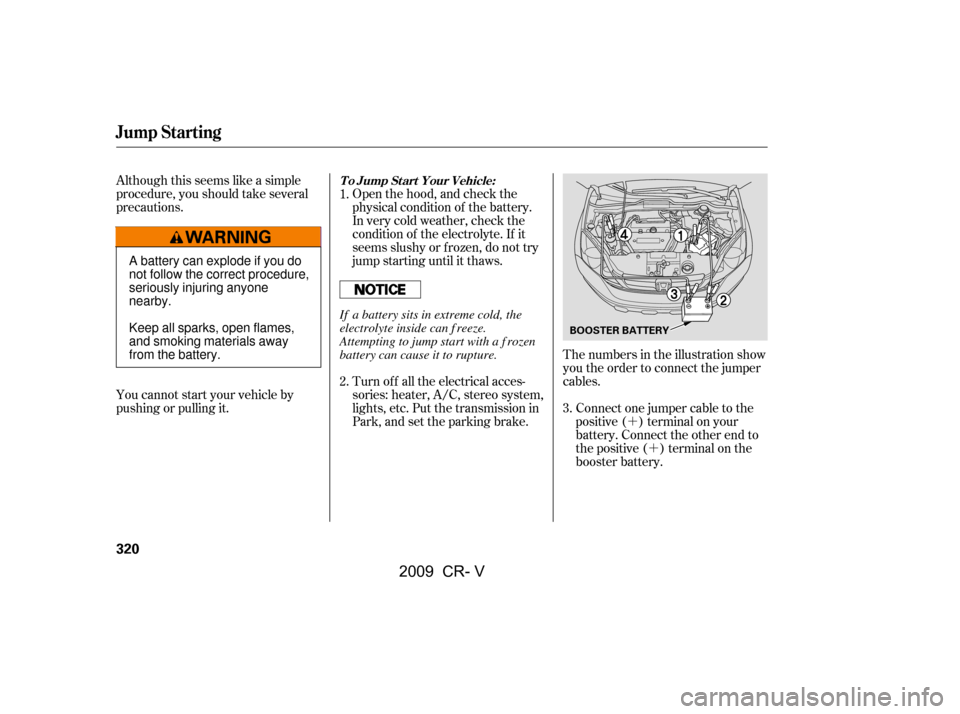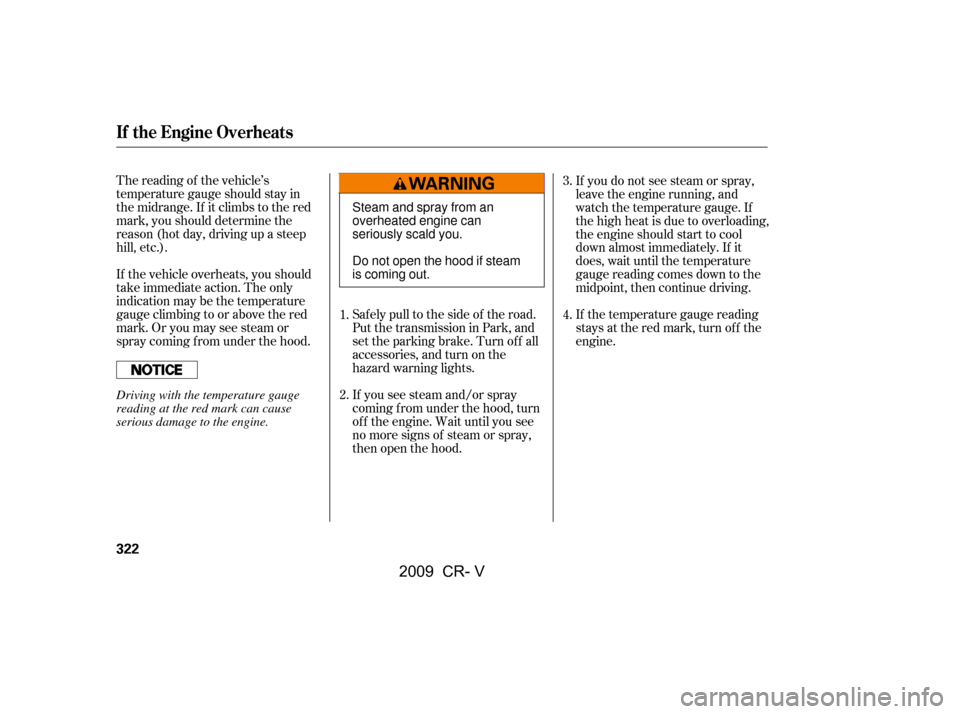Page 324 of 373

�´
�´
Although this seems like a simple
procedure, you should take several
precautions.
Open the hood, and check the
physical condition of the battery.
In very cold weather, check the
condition of the electrolyte. If it
seems slushy or f rozen, do not try
jump starting until it thaws.
Connect one jumper cable to the
positive ( ) terminal on your
battery. Connect the other end to
the positive ( ) terminal on the
booster battery.
The numbers in the illustration show
you the order to connect the jumper
cables.
You cannot start your vehicle by
pushing or pulling it.
Turn of f all the electrical acces-
sories: heater, A/C, stereo system,
lights, etc. Put the transmission in
Park, and set the parking brake.
1.
2.
3.
To Jump Start Your Vehicle:
Jump Starting
320
BOOSTER BATTERY
A battery can explode if you do
not follow the correct procedure,
seriously injuring anyone
nearby.
Keep all sparks, open flames,
and smoking materials away
from the battery.
If a battery sits in extreme cold, the
electrolyte inside can f reeze.
Attempting to jump start with a f rozen
battery can cause it to rupture.
�����—�����—�����y�
�������������y���
�(�,���������y���������y
2009 CR- V
Page 326 of 373

If the vehicle overheats, you should
take immediate action. The only
indication may be the temperature
gauge climbing to or above the red
mark. Or you may see steam or
spray coming f rom under the hood.
The reading of the vehicle’s
temperature gauge should stay in
the midrange. If it climbs to the red
mark, you should determine the
reason (hot day, driving up a steep
hill, etc.).
If you do not see steam or spray,
leave the engine running, and
watch the temperature gauge. If
the high heat is due to overloading,
the engine should start to cool
down almost immediately. If it
does, wait until the temperature
gauge reading comes down to the
midpoint, then continue driving.
If the temperature gauge reading
stays at the red mark, turn off the
engine.
If you see steam and/or spray
coming f rom under the hood, turn
of f the engine. Wait until you see
no more signs of steam or spray,
then open the hood.
Saf ely pull to the side of the road.
Put the transmission in Park, and
set the parking brake. Turn of f all
accessories, and turn on the
hazard warning lights.
1.
2.
3.
4.
If theEngineOverheats
322
Steam and spray from an
overheated engine can
seriously scald you.
Do not open the hood if steam
is coming out.
Driving with the temperature gauge
reading at the red mark can cause
serious damage to the engine.
�����—�����—�����y�
�������������y���
�(�,���������y���������y
2009 CR- V
Page 328 of 373

Let the vehicle sit f or a minute.
Open the hood, and check the oil
level (see page ). An engine
very low on oil can lose pressure
during cornering and other driving
maneuvers.
If necessary, add oil to bring the
level back to the full mark on the
dipstick (see page ).
Saf ely pull of f the road, and shut
of f the engine. Turn on the hazard
warning lights.
Start the engine, and watch the oil
pressure indicator. If it does not go
out within 10 seconds, turn of f the
engine. There is a mechanical
problem that needs to be repaired
bef ore you can continue driving
(seeon page
).
This indicator should never come on
when the engine is running. If it
starts flashing or stays on, the oil
pressure has dropped very low or
lost pressure. Serious engine
damage is possible, and you should
take immediate action.
If the charging system indicator
comes on brightly when the engine
is running, the battery is not being
charged.
Immediately turn of f all electrical
accessories. Try not to use other
electrically operated controls such as
the power windows. Keep the engine
running; starting the engine will
discharge the battery rapidly.
Go to a service station or garage
where you can get technical
assistance.
1.
2.
4.
3.
230
281
332 Emergency T owing
L ow Oil Pressure
Indicator
Charging System
Indicator
L ow Oil Pressure Indicator, Charging System Indicator
324
Running the engine with low oil
pressure can cause serious mechanical
damage almost immediately. Turn of f
the engine as soon as you can saf ely get
the vehicle stopped.
�\f���—�\f���—�����y�
���������
���y���
�(�,�������\f�y�\f�������y
2009 CR- V
Page 331 of 373
The interior f use box is located
under the dashboard on the driver’s
side. The f use label is attached
under the steering column.The under-hood f use box is on the
driver’s side. To open it, push the
tabs as shown.If something electrical in your
vehicle stops working, check f or a
blown f use f irst. Determine f rom the
chart on pages and , or the
diagram on the f use box lid, which
f use or f uses control that device.
Check those f uses f irst, but check all
the f uses bef ore deciding that a
blown f use is the cause. Replace any
blown f uses, and check if the device
works.
The vehicle’s f uses are contained in
two f use boxes. 330
331
CONT INUED
Checking and Replacing Fuses
Fuses
T aking Care of t he Unexpect ed
327
TAB
INTERIOR UNDER-HOOD
(PRIMARY)
FUSE LABEL
FUSE
�\f���—�\f���—�����y�
�������������y���
�(�,�������\f�y�\f�������y
2009 CR- V
Page 362 of 373

.............
Halogen Headlight Bulbs .291
..............
Hazard Warning Flashers .76
Headlights
........................................
Aiming .291
............
Daytime Running Lights .75
..................
High Beam Indicator .63
.........................
Reminder Chime .75
........
Replacing Halogen Bulbs .291
...................................
Turning on .74
..............................
Head Restraints .98
.............................
Heated Mirrors .112
...................................
Heater, Seat .108
.....................
Heating and Cooling .126............................
High Beam Lever .74
.......................
Hood, Opening the .229
..............................................
Horn .4,72
...
Identif ication Number, Vehicle .334
Ignition
..............................................
Keys .79
...........................................
Switch .81
............
Timing Control System .345
........................
Immobilizer System .80
.........
Important Safety Precautions .6
.................
Folding Rear Seat .102,104
..........................
Four-way Flashers .76
..............................
Front Airbags .9,25
Front Seat ......................................
Adjusting .95
.......................................
Heaters .108
.....................................
Airbags .9,25
.................................................
Fuel .226
........
Check Fuel Cap Message .228
......................
Fill Door and Cap .227
.....................
Low Fuel Indicator .63
...........................................
Gauge .66
................
Octane Requirement .226
...............................
Oxygenated .226
........................
Tank, Ref ueling .227
...............................
Fuel Economy .231
.....................
Fuses, Checking the .327
...............
Gas Mileage, Improving .232
..........................................
Gasohol .226
.........................................
Gasoline .226
.....................
Low Fuel Indicator .63
...........................................
Gauge .69
................
Octane Requirement .226 ........................
Tank, Ref ueling .227
................
Gas Station Procedures .227
Gauges
...
Engine Coolant Temperature .69
...............................................
Fuel .69
Gearshif t Lever Positions ..........
Automatic Transmission .247
......................................
Glove Box .117
Gross Vehicle Weight Rating .............................
(GVWR) .262,336
Index
G HI
IV
�\f���—�\f���—�����y�
������
������y���
�(�,�������\f�y�\f�������y
2009 CR- V